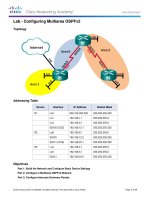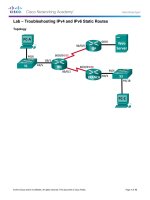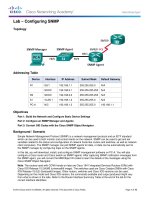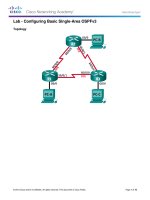wireshark network security piyush verma3479 kho tài liệu bách khoa
Bạn đang xem bản rút gọn của tài liệu. Xem và tải ngay bản đầy đủ của tài liệu tại đây (6.47 MB, 138 trang )
Wireshark Network Security
A succinct guide to securely administer your network
using Wireshark
Piyush Verma
BIRMINGHAM - MUMBAI
Wireshark Network Security
Copyright © 2015 Packt Publishing
All rights reserved. No part of this book may be reproduced, stored in a retrieval
system, or transmitted in any form or by any means, without the prior written
permission of the publisher, except in the case of brief quotations embedded in
critical articles or reviews.
Every effort has been made in the preparation of this book to ensure the accuracy
of the information presented. However, the information contained in this book is
sold without warranty, either express or implied. Neither the author, nor Packt
Publishing, and its dealers and distributors will be held liable for any damages
caused or alleged to be caused directly or indirectly by this book.
Packt Publishing has endeavored to provide trademark information about all of the
companies and products mentioned in this book by the appropriate use of capitals.
However, Packt Publishing cannot guarantee the accuracy of this information.
First published: July 2015
Production reference: 1240715
Published by Packt Publishing Ltd.
Livery Place
35 Livery Street
Birmingham B3 2PB, UK.
ISBN 978-1-78439-333-5
www.packtpub.com
Credits
Author
Piyush Verma
Reviewers
David Guillen Fandos
Project Coordinator
Nidhi Joshi
Proofreader
Safis Editing
Mikael Kanstrup
Jaap Keuter
Tigran Mkrtchyan
Commissioning Editor
Amarabha Banerjee
Acquisition Editor
Larissa Pinto
Content Development Editor
Siddhesh Salvi
Technical Editor
Madhunikita Sunil Chindarkar
Copy Editor
Dipti Mankame
Indexer
Priya Sane
Production Coordinator
Shantanu N. Zagade
Cover Work
Shantanu N. Zagade
About the Author
Piyush Verma currently serves as a senior security analyst at NII Consulting,
India, and enjoys hacking his way into organizations (legally) and fixing the
vulnerabilities encountered. He strongly values hands-on experience over
certifications; however, here are a few certifications he has earned so far: OSCP,
CEH, CHFI, CCNA Security, and CompTIA Security+. He is a highly sought-after
professional speaker and has delivered security training to folks working in public,
private, and "secret" sectors. He can be contacted at />infosecpiyushverma.
Acknowledgment
G.B. Stern quoted: "Silent gratitude isn't much use to anyone."
First and foremost, my deepest gratitude goes to my family, for being the perfect mix
of love and chaos. My father, for his guidance and faith in my decisions; my mother,
for her unconditional love and the awesome delicacies I much relish; and my sisters,
for their love and support.
Thanks to these influential personalities in my journey so far: Mr. Dheeraj Katarya,
my mentor, for all that you've taught me, which goes beyond the technical lessons;
Mr. Sanjay Sharma, who is always a big motivator; Mr. Rahul Kokcha, for making
the most difficult concepts easy to comprehend; Mr. Santosh Kumar, for his expert
insights on Wireshark; Mr. K.K. Mookhey, for whom nothing is unachievable and
he strives even bigger; Mr. Jaideep Patil, who is lavish in his praise and hearty in
his approbation.
It has indeed been a pleasure to work with some of the great minds of the industry.
Thanks to Mr. Wasim Halani, who has an answer for everything relevant and
is rightly called the "Google" of our organization; Mr. Vikash Tiwary, for whom
nothing matches his enthusiasm and the depth of knowledge he possesses. Special
thanks to Saman, Parag, and Avinash for their feedback.
I'd also like to thank my friends, who made the most difficult times fun and fun
times the most memorable.
Also, this book would have been difficult to achieve without the fantastic editorial
team at Packt Publishing and the prodigious reviewers who helped bring out the
best in me.
Ultimately, as the genius Albert Einstein quoted:
"I am thankful to all those who said no. It's because of them I did it myself."
About the Reviewers
David Guillen Fandos is a young Spanish engineer who enjoys being surrounded
by computers and anything related to them. He pursued both his degrees, an MSc in
computer science and an MSc in telecommunications, in Barcelona and has worked
in the microelectronics industry since then.
He enjoys playing around in almost any field, including network security, software
and hardware reverse engineering, and anything that could be considered security.
Despite his age, David enjoys not-so-new technologies and finds himself working
with compilers and assemblers. In addition to networking, he enjoys creating
hacking tools to exploit various types of attacks.
David is now working at ARM after spending almost 2 years at Intel, where he does
some hardware-related work in the field of microprocessors.
I'd like to thank those people in my life who continuously challenge
me to do new things, do things better than we do, or just change the
way we look at life—especially those who believe in what they do
and who never surrender no matter how hard it gets.
Mikael Kanstrup is a software engineer with a passion for adventure and the
thrills in life. In his spare time, he likes kitesurfing, riding motocross, or just being
outdoors with his family and two kids. Mikael has a BSc degree in computer
science and years of experience in embedded software development and computer
networking. For the past decade, he has been working as a professional software
developer in the mobile phone industry.
Jaap Keuter has been working as a development engineer in the telecommunications
industry for telephony to Carrier Ethernet equipment manufacturers for the past
2 decades. He has been a Wireshark user since 2002 and a core developer since 2005.
He has worked on various internal and telephony-related features of Wireshark as
well as custom-made protocol dissectors, fixing bugs and writing documentation.
Tigran Mkrtchyan studied physics at Yerevan State University, Armenia,
and started his IT career as an X25 network administrator in 1995. Since 1998, he has
worked at Deutsches Elektronen-Synchrotron (DESY)—an international scientific
laboratory, located in Hamburg, Germany. In November 2000, he joined the dCache
project, where he leads the development of the open source distributed storage
system, which is used around the world to store and process hundreds of petabytes
of data produced by the Large Hadron Collider at CERN. Since 2006, Tigran has
been involved in IETF, where he takes an active part in NFSv4.1 protocol definition,
implementation, and testing. He has contributed to many open source projects,
such as the Linux kernel, GlassFish application server, Wireshark network packet
analyzer, ownCloud, and others.
DESY is a national research center in Germany that operates particle accelerators
used to investigate the structure of matter. DESY is a member of the Helmholtz
Association and operates at sites in Hamburg and Zeuthen.
DESY is involved in the International Linear Collider (ILC) project. This project
consists of a 30-km-long linear accelerator. An international consortium decided to
build it with the technology developed at DESY. There has been no final decision on
where to build the accelerator, but Japan is the most likely candidate.
www.PacktPub.com
Support files, eBooks, discount offers, and more
For support files and downloads related to your book, please visit www.PacktPub.com.
Did you know that Packt offers eBook versions of every book published, with PDF
and ePub files available? You can upgrade to the eBook version at www.PacktPub.com
and as a print book customer, you are entitled to a discount on the eBook copy. Get in
touch with us at for more details.
At www.PacktPub.com, you can also read a collection of free technical articles, sign
up for a range of free newsletters and receive exclusive discounts and offers on Packt
books and eBooks.
TM
/>
Do you need instant solutions to your IT questions? PacktLib is Packt's online digital
book library. Here, you can search, access, and read Packt's entire library of books.
Why subscribe?
• Fully searchable across every book published by Packt
• Copy and paste, print, and bookmark content
• On demand and accessible via a web browser
Free access for Packt account holders
If you have an account with Packt at www.PacktPub.com, you can use this to access
PacktLib today and view 9 entirely free books. Simply use your login credentials for
immediate access.
Table of Contents
Prefacev
Chapter 1: Getting Started with Wireshark – What, Why,
and How?
1
Sniffing
1
The purpose of sniffing
2
Packet analysis
2
The tools of the trade
4
What is Wireshark?
5
The Wireshark interface – Before starting the capture
6
Title6
Menu6
Main toolbar
7
Filter toolbar
7
Capture frame
9
Capture Help
13
The Files menu
13
Online14
The Status bar
14
First packet capture
15
Summary17
Chapter 2: Tweaking Wireshark
Filtering our way through Wireshark
Capture filters
Display filters
The list of display filters
Wireshark profiles
Creating a new profile
19
19
21
22
24
25
25
[i]
Table of Contents
Essential techniques in Wireshark
27
The Summary window
27
The Protocol Hierarchy window
28
The Conversations window
28
The Endpoints window
29
The Expert Infos window
32
Wireshark command-line fu
32
tshark33
Starting the capture
33
Saving the capture to a file
34
Using filters
34
Statistics34
capinfos
35
editcap
35
mergecap36
Summary
36
Chapter 3: Analyzing Threats to LAN Security
Analyzing clear-text traffic
Viewing credentials in Wireshark
37
38
38
FTP39
Telnet39
HTTP40
TFTP41
Reassembling data stream
41
Case study
41
Examining sniffing attacks
MAC flooding
ARP poisoning
Analyzing network reconnaissance techniques
Examining network scanning activities
43
44
45
46
46
OS fingerprinting attempts
Detect password cracking attempts
Brute-force attacks
53
54
54
Detect the scanning activity for live machines
Identify port scanning attempts
Other scanning attempts
Identifying POP3 password cracking
HTTP basic authentication
Dictionary-based attacks
46
48
52
55
55
56
Detecting FTP password cracking
56
Miscellaneous attacks
FTP bounce attack
57
57
[ ii ]
Table of Contents
DNS zone transfer
57
SSL stripping attack
58
Complementary tools to Wireshark
59
Xplico
59
Sysdig61
Pcap2XML
62
SSHFlow63
Important display filters
65
Filters based on protocols
65
DNS
65
FTP
65
HTTP66
Filters based on unique signatures and regular expressions
Regular expressions
67
67
Nailing the CTF challenge
68
Summary74
Chapter 4: Probing E-mail Communications
E-mail forensics challenges
Challenge 1 – Normal login session
Challenge 2 – Corporate espionage
Analyzing attacks on e-mail communications
Detecting SMTP enumeration
Using an auxiliary module in Metasploit
Analyzing SMTP relay attack
Important filters
Summary
Chapter 5: Inspecting Malware Traffic
Gearing up Wireshark
Updated columns
Updated coloring rules
Important display filters
Malicious traffic analysis
Case study – Blackhole exploit kit
Protocols in action
The IP address of the infected box
Any unusual port number
A compromised website
Infected file(s)
Conclusion
75
76
76
78
83
84
84
85
85
86
87
88
88
89
89
90
90
90
91
92
94
96
98
IRC botnet(s)
Inspection
Summary
99
99
102
[ iii ]
Table of Contents
Chapter 6: Network Performance Analysis
103
Creating a custom profile for troubleshooting
104
Optimization before analysis
105
TCP-based issues
106
Case study 1 – Slow Internet
107
Analysis
108
Case study 2 – Sluggish downloads
108
Analysis109
Case study 3 – Denial of Service
110
SYN flood
111
Summary111
Index113
[ iv ]
Preface
Wireshark is the tool of choice for network administration and troubleshooting,
but its scalability goes beyond that. It is an excellent aid in performing an in-depth
analysis of issues pertaining to the overall security of the network. Several tools
and devices are available in the market to detect network-related attacks and take
appropriate actions based on a predefined set of rules. However, at a very granular
level, it all boils down to frames, or sometimes interchangeably called as packets,
and the data they carry.
This book is written from the standpoint of using Wireshark to detect securityconcerning flaws in commonly used network protocols and analyze the attacks from
popular tools such as Nmap, Nessus, Ettercap, Metasploit, THC Hydra, and Sqlmap.
In the later part of the book, we will dive into inspecting malware traffic from an
exploit kit and IRC botnet and solve real-world Capture-The-Flag (CTF) challenges
using Wireshark, basic Python code, and tools that complement Wireshark.
What this book covers
Chapter 1, Getting Started with Wireshark – What, Why, and How?, provides an
introduction to sniffing and packet analysis and its purpose. Later, we will look at
where Wireshark fits into the picture and how it can be used for packet analysis by
performing our first packet capture.
Chapter 2, Tweaking Wireshark, discusses the robust features of Wireshark and how
they can be useful in terms of network security. We will briefly discuss the different
command-line utilities that ship with Wireshark.
[v]
Preface
Chapter 3, Analyzing Threats to LAN Security, dives into performing sniffing and
capturing user credentials, analyzing network scanning attempts, and identifying
password-cracking activities. In this chapter, we will also learn to use important
display filters based on protocols and common attack-tool signatures and
also explore regular expression-based filters. Then we will look at tools that
complement Wireshark to perform further analysis and finally nail an
interesting CTF challenge via the techniques learned in the chapter.
Chapter 4, Probing E-mail Communications, focuses on analyzing attacks on
protocols used in e-mail communication and solving a couple of real-world
e-mail communication challenges using Wireshark.
Chapter 5, Inspecting Malware Traffic, starts with creating a new profile under
Wireshark for malware analysis and then picks up a capture file from an exploit kit
in action and diagnoses it with the help of Wireshark. Later, we also give a brief on
inspecting IRC-based botnets.
Chapter 6, Network Performance Analysis, begins by creating a troubleshooting profile
under Wireshark and then discusses and analyzes TCP-based issues and takes up
case studies of slow Internet, sluggish downloads, and delves further into picking up
on Denial-of-Service attacks using Wireshark.
What you need for this book
To work with this book, you will need to download and install Wireshark on the
operating system of your choice, and basic TCP/IP knowledge will be a plus.
Who this book is for
If you are a network administrator or a security analyst with an interest in using
Wireshark for security analysis, this is the book for you. Basic familiarity with
common network and application service terms and technologies is assumed;
however, expertise in advanced networking topics or protocols is not required.
Conventions
In this book, you will find a number of text styles that distinguish between different
kinds of information. Here are some examples of these styles and an explanation of
their meaning.
Code words in text, database table names, folder names, filenames, file extensions,
pathnames, dummy URLs, user input, and Twitter handles are shown as follows:
"An indicator in that case will be the visibility of popular IRC commands as USER,
NICK, JOIN, MODE, and USERHOST."
[ vi ]
Preface
Any command-line input or output is written as follows:
frame contains "\x50\x4B\x03\x04"
New terms and important words are shown in bold. Words that you see on the
screen, for example, in menus or dialog boxes, appear in the text like this: "To enable
or disable the title, navigate to Edit | Preferences | User Interface and modify the
option Welcome screen and title bar shows version to suit your requirement."
Warnings or important notes appear in a box like this.
Tips and tricks appear like this.
Reader feedback
Feedback from our readers is always welcome. Let us know what you think about
this book—what you liked or disliked. Reader feedback is important for us as it helps
us develop titles that you will really get the most out of.
To send us general feedback, simply e-mail , and mention
the book's title in the subject of your message.
If there is a topic that you have expertise in and you are interested in either writing
or contributing to a book, see our author guide at www.packtpub.com/authors.
Customer support
Now that you are the proud owner of a Packt book, we have a number of things to
help you to get the most from your purchase.
Downloading the color images of this book
We also provide you with a PDF file that has color images of the screenshots/
diagrams used in this book. The color images will help you better understand the
changes in the output. You can download this file from ktpub.
com/sites/default/files/downloads/3335OS_ColoredImages.pdf.
[ vii ]
Preface
Errata
Although we have taken every care to ensure the accuracy of our content, mistakes
do happen. If you find a mistake in one of our books—maybe a mistake in the text or
the code—we would be grateful if you could report this to us. By doing so, you can
save other readers from frustration and help us improve subsequent versions of this
book. If you find any errata, please report them by visiting ktpub.
com/submit-errata, selecting your book, clicking on the Errata Submission Form
link, and entering the details of your errata. Once your errata are verified, your
submission will be accepted and the errata will be uploaded to our website or
added to any list of existing errata under the Errata section of that title.
To view the previously submitted errata, go to />content/support and enter the name of the book in the search field. The required
information will appear under the Errata section.
Piracy
Piracy of copyrighted material on the Internet is an ongoing problem across all
media. At Packt, we take the protection of our copyright and licenses very seriously.
If you come across any illegal copies of our works in any form on the Internet, please
provide us with the location address or website name immediately so that we can
pursue a remedy.
Please contact us at with a link to the suspected
pirated material.
We appreciate your help in protecting our authors and our ability to bring you
valuable content.
Questions
If you have a problem with any aspect of this book, you can contact us at
, and we will do our best to address the problem.
[ viii ]
Chapter 1
Getting Started with
Wireshark – What, Why,
and How?
Sniffing and interpreting traffic on the network has been and always will be
an integral part of a network analyst's job profile. It is not only restricted to the
network analyst's profession, but it also plays a significant role in the fields of
software development, network security, and digital forensics. Wireshark is the tool
of choice at most workplaces and does not seem to slow down in terms of popularity
and features, hence making it a "must-know" tool. This chapter gives a briefing on:
• Sniffing and its purpose
• Tools of the trade
• Getting up and running with Wireshark
Sniffing
Sniffing, by definition, is using our sense of smell to savor something, like a sniff
of perfume. In this case, our nose acts as a sniffer. We can perform sniffing on the
network using various tools categorized as packet sniffers to capture or collect the
packets flowing in our networks. They are simply a way for us to see the network
traffic and bandwidth information over the entire IT infrastructure. The technique
of using a packet sniffer to sniff the data flowing over the wire or through thin air
(wireless) is called packet sniffing.
[1]
Getting Started with Wireshark – What, Why, and How?
The purpose of sniffing
Packet sniffing is performed in order to better understand what flows through our
networks. Just as a poison flowing through the veins of the human body has the
potential to kill an individual, similarly malicious traffic traversing our networks can
have a severe and sometimes irreparable effect on the network devices, performance,
and business continuity.
Sniffing helps a network analyst verify whether the implementation and
functionality of the network and network security devices, such as the router,
switch, firewall, IDS, or IPS, are as expected and also confirms that data is
traversing through secure channels of communication.
Security analysts use sniffing to gather evidence in the case of a security breach with
regard to the source of the attack, time and duration of the attack, protocols and port
numbers involved, and data transmitted for the purpose of the attack. It can also help
to prove the use of any insecure protocol(s) used to transmit sensitive information.
As Christopher Hitchens, a British-born American author, was once quoted saying:
"That which can be asserted without evidence, can be dismissed without evidence."
Using a packet sniffer helps us get that piece of evidence.
Packet analysis
Now, to figure out whether the smell of the perfume is pleasant, ambrosial,
or reeking is the analysis part. Hence, the art of interpreting and analyzing
packets flowing through the network is known as packet analysis or network
analysis. Mastering this art is a well-honed skill and can be achieved if a network
administrator has a solid understanding of the TCP/IP protocol suite, is familiar
with packet flows, and has an excellent grasp of any sniffer of choice.
Learning technology at the packet level helps to cement the most difficult concepts. For
an easy example, let's say that a user wants to browse a website named example.com.
As soon as the user enters the URL in the address bar and hits GO, the packets start to
flow on the network with respect to that request. To understand this packet flow, we
need to start sniffing to look at the packets in transit. The following screenshot shows
the packets that traversed the network when the user opened example.com.
[2]
Chapter 1
We can analyze the packets after capturing them using a sniffer of choice, and in
our case, we notice the columns that tell us about the source and destination IP
addresses, the protocol being used, the length of the individual packets, and other
relevant information. We will be digging into more detailed analysis as we progress
though this book.
When we talk about enterprise networks, at any given point, there is humongous
amount of traffic on the wire and analyzing such traffic is not a walk in the park.
This traffic may be generated by numerous network devices communicating among
each other, servers responding to user requests, or making their own requests over
the Internet when required, and end users trying to accomplish their day-to-day
tasks at work. There is no better way to understand this flow of information than
to perform a packet-level analysis and, as the famous quote about network analysis
goes, packets never lie. In addition, Gerald Combs, the man behind Wireshark, once
tweeted the following:
""The packets never lie" but as traffic volumes increase you end up with a trillion
truths. The trick is finding the important ones."
Learning such tricks comes only with experience, as with anything else in the field
of IT. As an example, if you want to improve your programming skills, you have to
practice code writing day in and day out to be able to write structured and optimized
pieces of code that can perform magic. The same goes for packet analysis.
Packet analysis can further help an administrator to:
• Monitor and provide a detailed statistics of activities on the network
• Distinguish between normal and unusual traffic
• Perform network diagnostics
• Identify and resolve network performance issues such as excessive
bandwidth utilization
• Conduct deep packet inspection
• Investigate security breaches
[3]
Getting Started with Wireshark – What, Why, and How?
The tools of the trade
There are numerous free and commercial packet sniffers, very often named network
analyzers, in the market, and selecting the one that best meets your need is a matter
of choice. There are several factors to determine this, such as the operating system in
use, supported set of protocols, ease of use, customizability, and of course budget.
The following are the popular ones:
• Tcpdump: Tcpdump is a free and popular command-line packet capture
utility, which can come in very handy in the absence of a GUI-based tool.
However, even after capturing traffic via tcpdump, one can analyze and
interpret the traffic using any GUI-based free or commercial tool, as it is
visually easy. Refer to TCPDUMP Overview at />manpages/tcpdump.1.html.
• Nagios Network Analyzer and OmniPeek: These are commercial-grade
network analyzers that provide organizations with packet analysis
capabilities with some unique features of their own. The pricing for these
products can be seen on their individual websites.
• Wireshark: Wireshark, formerly known as Ethereal, is free and open source,
and is the most popular packet analyzer out there. It works across multiple
platforms and supports a huge set of protocol families with an easy-to-use
GUI. Refer to />Apart from the dedicated sniffer tools we just introduced, packet sniffing capability
and modules come integrated in many of the popular security-related tools, such as
Snort, Metasploit, and Scapy, to name a few. Snort started off as a sniffer and later
used its sniffing capabilities to develop into what we know today as the popular
network intrusion prevention system (NIPS) and network intrusion detection
system (NIDS) solution.
Another example is the presence of the sniffer module in Metasploit. After
successfully compromising a machine using Metasploit, one can execute this module
and start sniffing traffic on that compromised box for further enumeration. Sniffing
options available with Metasploit are shown as follows:
[4]
Chapter 1
Another excellent option is using sniff() in Scapy. Scapy is a packet manipulation
tool written in Python and can be used to generate, craft, and decode packets and
capture them. It is helpful in many security testing-related activities.
The focus of this book is "Wireshark". So, let's get started.
What is Wireshark?
Wireshark, as discussed earlier, is the most popular packet analyzer, and there is a
reason behind its huge fan following. It hosts tons of features, supports a huge list of
common and uncommon protocols with an easy-to-navigate GUI, and can be easily
installed and used on popular operating systems, such as Windows, Linux, and Mac
OS X for absolutely no cost at all.
Wireshark can be downloaded and installed from the official website (http://www.
wireshark.org). The installation setup is comparatively simple, and within a few
clicks, you will be up and running with Wireshark on a Windows machine.
Installation guidelines for Windows, Unix, and Mac OS X can be
found at />chunked/ChapterBuildInstall.html.
As of writing this, the most recent version is Wireshark 1.12.6. Once downloaded and
installed, you should be able to start Wireshark and will be presented with a screen
similar to the one shown here:
[5]
Getting Started with Wireshark – What, Why, and How?
The Wireshark interface – Before starting
the capture
Let's get started with various aspects of the Wireshark interface.
Title
This contains the default title of Wireshark along with the current version in use.
To enable or disable the title, navigate to Edit | Preferences | User Interface
and modify the option Welcome screen and title bar shows version to suit your
requirement. To modify the title, navigate to Edit | Preferences | User Interface |
Layout and enter a suitable title in the Custom window title field as shown in the
following figure:
Note: This will be appended to the current title as shown in
the preceding screenshot.
Menu
The Menu bar hosts the features of Wireshark, all categorized under suitable titles.
These options will be taken up as and when required during the course of this
book. As an example, you can look at the authors involved in the development of
Wireshark by navigating to Help | About Wireshark and selecting the Authors tab.
This is how it will look:
[6]
Chapter 1
Main toolbar
The main toolbar contains the icons for more frequently used items in Wireshark.
You will note that some options are grayed out. This is because not all the options
are available in the current context. Once we start the capture, we will see most of
them highlighted and available for use.
Filter toolbar
Filtering the traffic can help analysts find a needle in a haystack. There are two types
of filtering options available in Wireshark. One is called capture filters, and the
second is called display filters.
[7]
Getting Started with Wireshark – What, Why, and How?
Capture filters define which frames will be captured and sent to Wireshark's capture
engine for processing and later displayed in Wireshark, while display filters define
which frames are displayed after they are captured. We can redefine display filters
without restarting the capture, which is not the case for capture filters; hence, we
need to be cautious with their usage. The Expression option on the side helps us
create the filter expressions in an easy way, as there is a huge list of filters, and we
don't need to waste our time memorizing them.
Wireshark aids by providing visual indicators whether or not a filter used by
us is correct (accepted by Wireshark), by changing the background color to red
(wrong filter expression) and to green (correct filter expression) as shown in the
following screenshot:
Wrong filter
This is the correct filter will look something like this:
Correct filter
You may notice that sometimes the filter shows a yellow background.
This might be due to the fact that the filter expression which you entered
is not working as expected. An example could be using
instead of the correct filter, that is,
.
Once the filter expression is ready, you can either press ENTER, or click on Apply
for that filter to be applied on the selected list of packets, and you can remove the
current filter expression by clicking on Clear.
Applying display filters on a large capture might take some time, and the
progress is visible.
[8]









